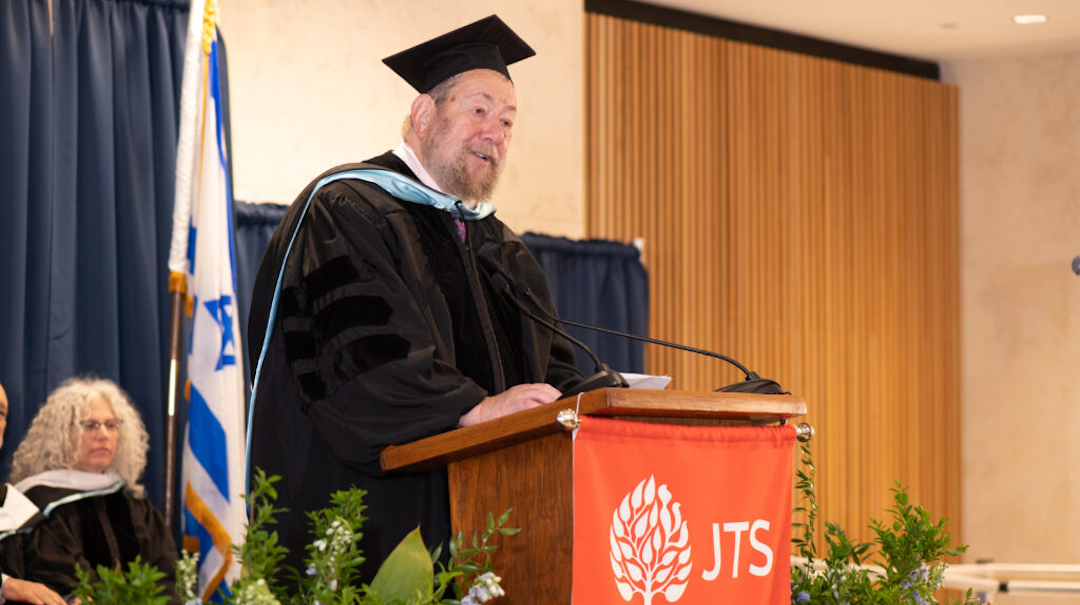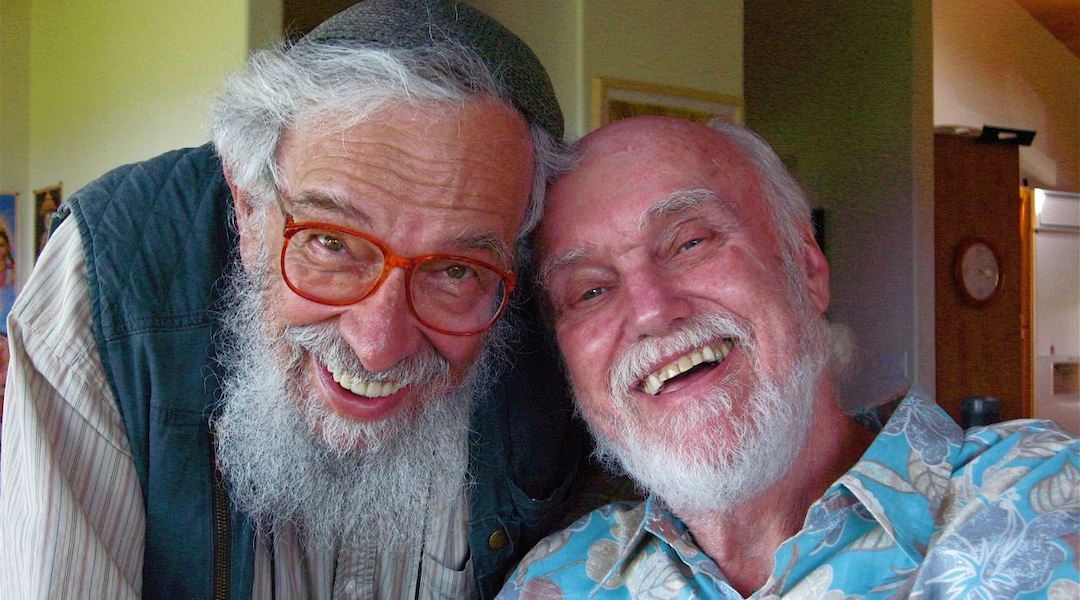(JTA) — Rabbi Arthur Green gave the commencement address last week at the Jewish Theological Seminary, the Conservative flagship where he was ordained 56 years earlier.
His talk was mostly a response to political turmoil in Israel, but he also urged the graduates to pioneer a “new Judaism.”
“I had the good fortune, as a young seeker, to run into the Jewish mystical tradition, especially the writings of the early Hasidic masters,” said Green, who taught Jewish mysticism and Hasidic theology at Brandeis, the University of Pennsylvania and Hebrew College. “I have been working for half a century to articulate what could simply be called a Judaism for adults living in freedom. I am now near the end of my creative course. But you young people are just at the beginning of yours. We need you to enroll — however you can — in the task of the generations, that of re-creating Judaism.”
That is the language of Jewish Renewal, with which Green, 82, is deeply identified. Renewal isn’t a denomination, really, but a movement that was born in and reflects the 1960s and 1970s counterculture. Baby boomer Jews disillusioned with the large suburban synagogues that they considered soulless embraced Jewish practice that was spiritual, egalitarian, environmentally conscious and largely lay-led.
Renewal’s signature institution was the havurah — intimate prayer, study and social fellowships. Its soundtrack were the liturgical melodies composed by the hippy-ish, “neo-Hasidic” Orthodox rabbi, Shlomo Carlebach. And its rebbe — to the degree that an egalitarian movement had a central figure — was Rabbi Zalman Schachter-Shalomi (1924-2014), a refugee from Hitler’s Europe and former Lubavitcher Hasid whose Judaism channeled the spiritual “New Age” of the 1970s.
These ideas and approaches may be familiar to you even if you’ve never heard of “Renewal.” Rare is the synagogue that doesn’t try to offer a more intimate spiritual experience for its worshippers, to shrink the distance between pulpit and pew, to incorporate new Jewish music and, in non-Orthodox and a number of Modern Orthodox synagogues, to increase the participation of women in prayer and study.
Those prayer shawls with rainbow stripes? That was a Schachter-Shalomi innovation.
How a counterculture movement came to be absorbed by the mainstream is the subject of a paper in a new collection, “The Future of Judaism in America.” edited by Jerome Chanes and Mark Silk. Chanes is the co-author, with Shaul Magid, of the chapter on “Renewal” that claims it as one of the most influential if not defining Jewish movements of the last 50 years.
“While Jewish Renewal has never boasted a large number of members, its influence on the larger American Jewish community has been significant, in terms of its liturgical experimentation, its revisions of ritual and its overall metaphysics,” they write. “It has also served as an ongoing conduit of information and inspiration from its own past — the havurah movement, radical politics, feminism — to the next generation.”
I came to the paper after giving a lecture at my own synagogue on “The Crisis of the American Synagogue.” I spoke of declining affiliation rates, plunging enrollment in supplementary schools, the shrinking number of non-Orthodox synagogues. Most of my adult life has been spent in synagogues, havurot and institutions heavily influenced by Renewal. If the Jewish Renewal movement revitalized synagogue life in the last century, could it also be blamed for its struggles in this one?
Magid, a fellow in Jewish studies at Dartmouth College, and Chanes, an adjunct professor of Jewish Studies at Baruch College, presented their chapter at a conference dedicated to the release of the book, held Tuesday and Wednesday at Trinity College in Hartford, Connecticut. Magid made the claim — considered bold, at this small gathering of Jewish historians — that the “three most important Jewish figures in 20th century America Judaism” were Mordecai Kaplan, Menachem Mendel Schneerson and Shachter-Shalomi.
Kaplan, the founder of Reconstructionist Judaism, downplayed the supernatural element of Judaism and instead called it a “civilization” defined by its people and culture. Schneerson, the Lubavitcher rebbe, turned an insular Orthodox sect into an outreach movement that promotes ritual practice among secular Jews.

Rabbi Arthur Green delivers the commencement address at the Jewish Theological Seminary in Manhattan, May 18, 2023. (Courtesy JTS)
Schachter-Shalomi combined their visions and imagined a Judaism, said Magid, that “is no longer used as a tool for Jewish survival, but rather as a project for Jews to become part of the global community, to contribute to the global community.” Environmental awareness became a hallmark of Renewal, as did absorbing influences from other religions, especially Eastern ones. “He really did take Schneerson’s teaching about bringing Judaism to the streets and expanded it further to bring Judaism to the mosque, to bring Judaism to the monastery, to create another way of being Jewish which was not afraid of the world.”
In an interview with Magid before the conference, I asked if he and Chanes might be exaggerating Renewal’s influence.
“I’m sure there will be people who will claim that case but I don’t think so, no,” he said. Magid acknowledges that few people regard themselves as direct disciples of Schachter-Shalomi, and yet, like Kaplan, his influence is felt widely and deeply. “Each one of them had a futuristic vision,” he said. “They were able to cultivate a way of thinking about Judaism that was before their time and that eventually came into being in many ways.”
One of those skeptical of Schachter-Shalomi’s influence is Jonathan Sarna, professor of Jewish history at Brandeis, who gave the keynote talk at the conference. In his response to the panel on Renewal, Sarna doubted Schachter-Shalomi was as influential as Carlebach, the Conservative theologian Abraham Joshua Heschel or the Modern Orthodox philosopher Joseph Soloveitchik. “I don’t think we should delude ourselves into thinking that every innovator is a new Moses,” Sarna said.
Benjamin Steiner, a visiting assistant professor in religion at Trinity, also wondered if Renewal had spread “everywhere in the country, or only in large urban areas with critical masses of educated Jewish students.”
Listening to Magid’s response to such caveats, I thought of the quote often attributed to music producer Brian Eno: “The first Velvet Underground album only sold 10,000 copies, but everyone who bought it formed a band.” Renewal’s influence spread beyond its founding havurot because many of their principals went on to important positions in academia and Jewish organizations, including Green, Rabbi Everett Gendler, Sharon Strassfeld, John Ruskay and Rabbi Arthur Waskow.
Small but influential Gen X and millennial institutions also bear Renewal’s fingerprints: the “Jewish Emergent Network” of independent congregations; New York’s Romemu and B’nai Jeshurun synagogues; egalitarian, traditional-style yeshivas like Hadar. Bayit, with a number of principals associated with ALEPH: the Alliance for Jewish Renewal, is an online artist’s collective and publisher of Jewish books, including a forthcoming Shabbat prayer book.
One of its contributors, Rabbi Rachel Barenblat, who was ordained by ALEPH, has argued that the influence of Renewal is felt even within Orthodoxy. “If you look at the Open Orthodoxy movement, if you look at the ordination of women as ‘maharats’ [by Yeshivat Maharat, a women’s seminary], the future of women as rabbinic leaders in Orthodoxy is already here,” she said on an episode of the “Judaism Unbound” podcast. “It’s not everywhere, but someday it will be.”
Magid and Chanes similarly claim a number of leading Jewish feminists as products of Renewal — they mention Paula Hyman, Eva Fogelman and Judith Plaskow — although some in the audience at Trinity insisted they gave Renewal too much credit for a movement by and for women. In her essay in the Chanes/Silk book, Sylvia Barack Fishman of Brandeis University offers a counter-narrative of Jewish innovation over the past 50 years. In her chapter, she credits the “active partnership” of women in revitalizing American Judaism: Women’s religious expressions, she writes, “create social contexts and are distinguished by a communal dynamic, quite unlike the isolated, personalized Jewish experience, which some have claimed defines contemporary Jewishness.”
I came away convinced that Renewal has had an outsize influence on Jewish life, especially for baby boomers like me. But I also wondered if its outward-facing, syncretic Judaism failed to instill a sense of obligation to Jewish forms, institutions and peoplehood — unlike, by contrast, Orthodoxy in all of its booming present-day manifestations.
I asked Magid in what ways Renewal might have fallen short.
“Part of its failure is that it is very, very anchored to a certain kind of American counterculture that no longer exists. It hasn’t really moved into a 2.0 phase,” he said. “There are students and staff members that are still very tied to [Schachter-Shalomi’s] vision, and then there’s a younger generation, Gen Z, who have read some of his work and they’re influenced by it, but they really are thinking much more about, well, how does this translate into a post-countercultural America?”
Magid also feels the ideas of Renewal will become more important as American Jews’ attachment to Israel wanes, and the living memory of the Holocaust recedes.
If Rabbi Green’s speech at the JTS graduation was any indication, then the ideals of Jewish Renewal still hold their appeal.
“We need a new Judaism in America… where we also have the fresh air needed to create it,” he said. “How do we move forward… in articulating a Jewish theology for today that is both intellectually honest and spiritually rewarding?”
The audience of future Jewish leaders and teachers leapt to its feet.
JTA has documented Jewish history in real-time for over a century. Keep our journalism strong by joining us in supporting independent, award-winning reporting.







